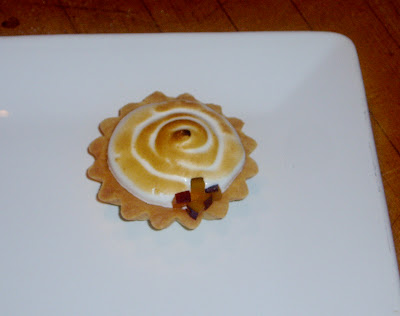
Plating desserts is such fun! You get to experiment with different textures, flavors, temperatures, colors, and shapes with results that are delicious and make people happy. All in all, I suppose it’s really just playtime with sweets.
It’s incredible how the same dessert component can morph depending on how it’s plated. Take a simple piece of chocolate cake for example…it could be cut in a triangle, or a circle or a rectangle…could be filled or not, have a sauce or not, be on a square plate or an oval plate or in a glass…and so on…forever.
However fun it can be, plating desserts is challenging. Although it might be easy to think up a bazillion plating ideas, when it comes to the actual dessert architecture, well that’s an entirely different story. The plate is too big, the cake isn’t the right shape, the sauce is too thick, ARGH.
Last week in class, we were given a stocked pantry (full of fruits, nuts and sauces) and were told to create two plated desserts.

The first dessert I put up was a Sugarplum and Chocolate Meringue Tartlet with Cocoa Nib Cookie Crumbs and Caramel Ice Cream.

The second dessert was a Nectarine Tea Cake and a Stone Fruit-Pistachio Verrine with Browned Butter and Rum Cream. A verrine is a layered dessert that is similar to a parfait.

Since dessert plating can induce mild anxiety attacks in the pastry-obsessed, it’s nice to have some pointers:
Go for odd numbers: Put 1 or 3 cookies on the plate instead of 2 or 4.
Balance is important but don’t be rely on symmetry: If you put a raspberry on one side of the plate, maybe put a few chopped nuts on the other side on a slight angle, or just leave it blank.
Try out different heights and shapes: Combine circles with lines and swooshes, etc.
Use interesting vessels: Try putting a custard in a jar or using a pretty glass or interesting looking plate, it’ll make a big difference.
Use a variety of textures and temperatures: Try to have something crunchy, something smooth, something warm and something cold on the plate.
The magic number 3: On a basic level, try to include the main dessert, a sauce and a garnish on each plate.
If you can’t eat it: Don’t put it on the plate…no matter how pretty it is.
Don’t put anything on the plate that isn’t in the main dessert: Just say NO to the random mint leaf!
Happy Plating!




1 comment:
your platings are beautiful!
Post a Comment